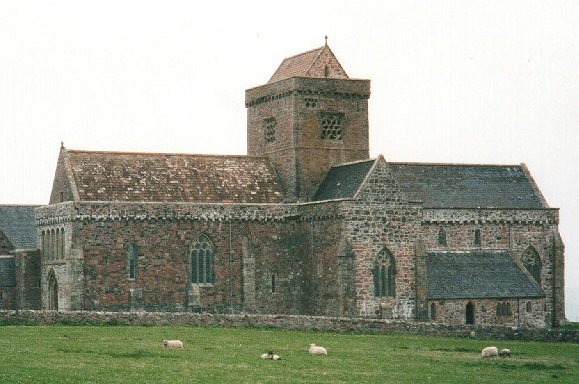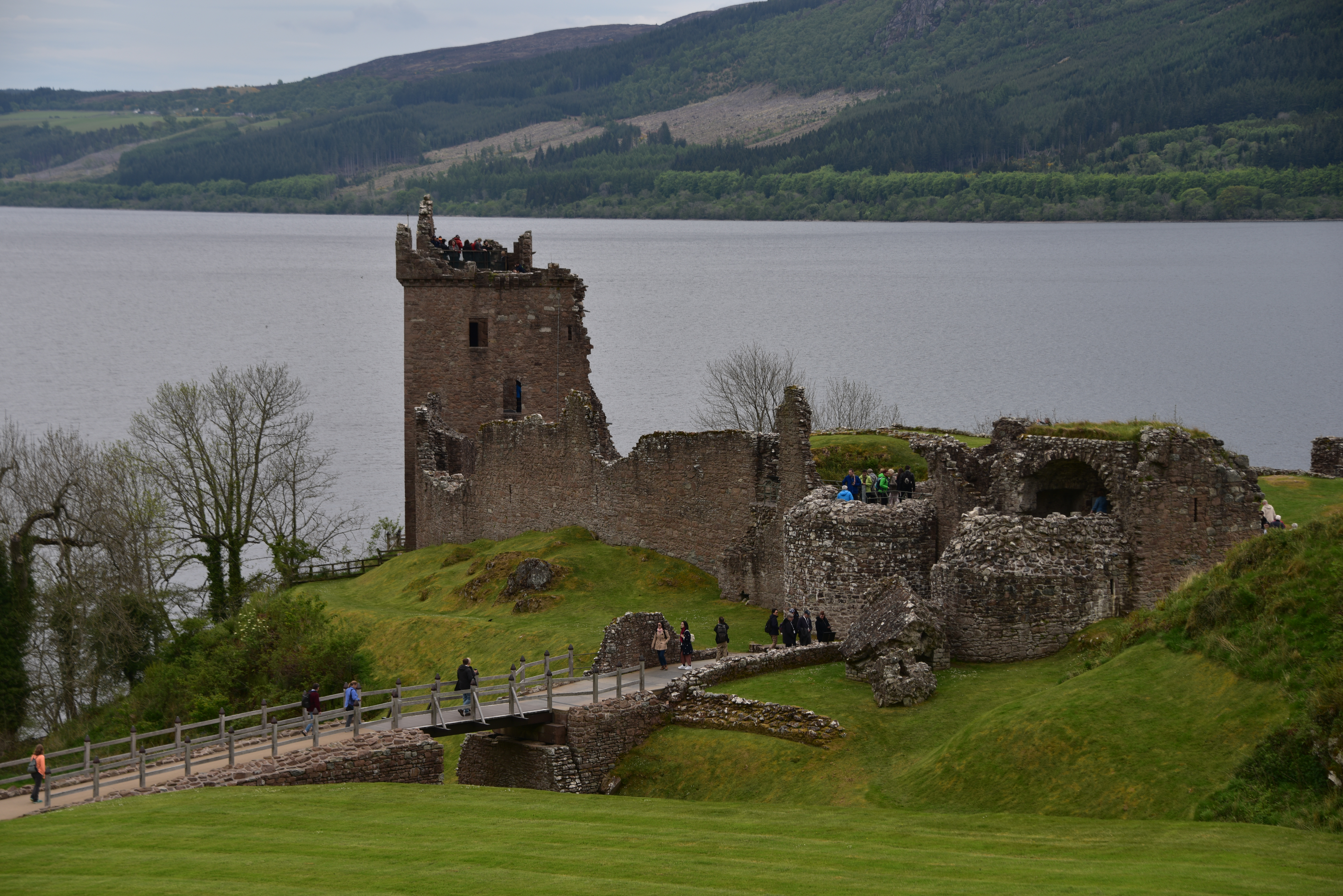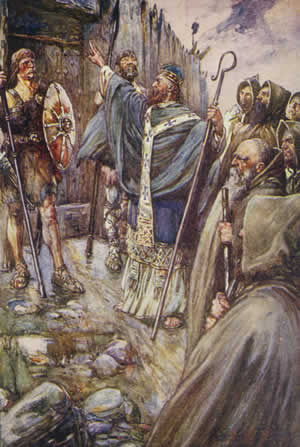|
Leslie Alcock
Leslie Alcock (24 April 1925 – 6 June 2006) was Professor of Archaeology at the University of Glasgow, and one of the leading archaeologists of Early Medieval Britain. His major excavations included Dinas Powys hill fort in Wales, Cadbury Castle in Somerset and a series of major hillforts in Scotland. Early years Alcock was born at Cheadle Hulme, Stockport, near Manchester, son of clerk Philip John Alcock and Mary Ethel (née Bagley). He won a scholarship to Manchester Grammar School in 1935. Alcock left school in 1942, subsequently joining the army and going on to serve as a captain in the Royal Gurkha Rifles during World War II. After demobilisation in 1946, he won a scholarship to Brasenose College, Oxford, where he read Modern History from 1946 to 1949. He pursued his interest in archaeology through the Oxford Archaeology Society, becoming its president. He met his wife Elizabeth during this period, and they were married in 1950, shortly before he left Britain to become ... [...More Info...] [...Related Items...] OR: [Wikipedia] [Google] [Baidu] |
University Of Glasgow
, image = UofG Coat of Arms.png , image_size = 150px , caption = Coat of arms Flag , latin_name = Universitas Glasguensis , motto = la, Via, Veritas, Vita , mottoeng = The Way, The Truth, The Life , established = , type = Public research universityAncient university , endowment = £225.2 million , budget = £809.4 million , rector = Rita Rae, Lady Rae , chancellor = Dame Katherine Grainger , principal = Sir Anton Muscatelli , academic_staff = 4,680 (2020) , administrative_staff = 4,003 , students = () , undergrad = () , postgrad = () , city = Glasgow , country = Scotland, UK , colours = , website = , logo ... [...More Info...] [...Related Items...] OR: [Wikipedia] [Google] [Baidu] |
Camelot
Camelot is a castle and court associated with the legendary King Arthur. Absent in the early Arthurian material, Camelot first appeared in 12th-century French romances and, since the Lancelot-Grail cycle, eventually came to be described as the fantastic capital of Arthur's realm and a symbol of the Arthurian world. The stories locate it somewhere in Great Britain and sometimes associate it with real cities, though more usually its precise location is not revealed. Most scholars regard it as being entirely fictional, its unspecified geography being perfect for chivalric romance writers. Nevertheless, arguments about the location of the "real Camelot" have occurred since the 15th century and continue today in popular works and for tourism purposes. Etymology The name's derivation is uncertain. It has numerous different spellings in medieval French Arthurian romances, including ''Camaalot'', ''Camalot'', ''Chamalot'', ''Camehelot'' (sometimes read as ''Camchilot''), ''Camaaloth ... [...More Info...] [...Related Items...] OR: [Wikipedia] [Google] [Baidu] |
Antiquity (journal)
''Antiquity'' is an academic journal dedicated to the subject of archaeology. It publishes six issues a year, covering topics worldwide from all periods. Its current editor is Robert Witcher, Associate Professor of Archaeology at the University of Durham. Since 2015, the journal has been published by Cambridge University Press. ''Antiquity'' was founded by the British archaeologist O. G. S. Crawford in 1927 and originally called ''Antiquity: A Quarterly Review of Archaeology''. The journal is owned by the Antiquity Trust, a registered charity. The current trustees are Graeme Barker, Amy Bogaard, Robin Coningham (chair), Barry Cunliffe, Roberta Gilchrist, Anthony Harding, Carl Heron, Martin Millett, Nicky Milner, Stephanie Moser, and Cameron Petrie. List of editors * O. G. S. Crawford (1927–1957) * Glyn Daniel (1958–1986) * Christopher Chippindale (1987–1997) * Caroline Malone (1998–2002) * Martin Carver (2003–2012) * Chris Scarre Christopher John Scarre, FSA is a ... [...More Info...] [...Related Items...] OR: [Wikipedia] [Google] [Baidu] |
Archives Of The University Of Glasgow
The Archives of the University of Glasgow (GUAS) maintain the historical records of the University of Glasgow back to its foundation in 1451. Its earliest record is a charter dating from 1304 for the lands of the earliest mention of record-keeping in the university is in 1490 when it is recorded in the Annales Universitatis Glasguensis 1451–1558 that 'in accordance with a proposition of the Lord Rector, a parchment book is ordered to be procured, in which important writs, statutes, and lists of the university, are to be engrossed: and also a paper book, for recording judicial proceedings.’ The Clerk to the Faculty, and subsequently the Clerk of Senate, maintained the records of the university due to the continuing requirement to ensure that the privileges, rights, policies and finances of the university were kept in good order. Overview The Clerk's Press is the oldest surviving piece of university furniture and was acquired in 1634 to hold such records. In 1955 the fir ... [...More Info...] [...Related Items...] OR: [Wikipedia] [Google] [Baidu] |
Stevenage
Stevenage ( ) is a large town and borough in Hertfordshire, England, about north of London. Stevenage is east of junctions 7 and 8 of the A1(M), between Letchworth Garden City to the north and Welwyn Garden City to the south. In 1946, Stevenage was designated the United Kingdom's first New Town under the New Towns Act. Etymology "Stevenage" may derive from Old English ''stiþen āc'' / ''stiðen āc'' / ''stithen ac'' (various Old English dialects cited here) meaning "(place at) the stiff oak". The name was recorded as ''Stithenæce'' in c.1060 and as ''Stigenace'' in the Domesday Book in 1086. History Pre-Conquest Stevenage lies near the line of the Roman road from Verulamium to Baldock. Some Romano-British remains were discovered during the building of the New Town, and a hoard of 2,000 silver Roman coins was discovered during house-building in the Chells Manor area in 1986. Other artefacts included a dodecahedron toy, fragments of amphorae for imported wine, bone hairpin ... [...More Info...] [...Related Items...] OR: [Wikipedia] [Google] [Baidu] |
Columba
Columba or Colmcille; gd, Calum Cille; gv, Colum Keeilley; non, Kolban or at least partly reinterpreted as (7 December 521 – 9 June 597 AD) was an Irish abbot and missionary evangelist credited with spreading Christianity in what is today Scotland at the start of the Hiberno-Scottish mission. He founded the important abbey on Iona, which became a dominant religious and political institution in the region for centuries. He is the patron saint of Derry. He was highly regarded by both the Gaels of Dál Riata and the Picts, and is remembered today as a Catholic saint and one of the Twelve Apostles of Ireland. Columba studied under some of Ireland's most prominent church figures and founded several monasteries in the country. Around 563 AD he and his twelve companions crossed to Dunaverty near Southend, Argyll, in Kintyre before settling in Iona in Scotland, then part of the Ulster kingdom of Dál Riata, where they founded a new abbey as a base for spreading Celtic Christia ... [...More Info...] [...Related Items...] OR: [Wikipedia] [Google] [Baidu] |
Adomnán
Adomnán or Adamnán of Iona (, la, Adamnanus, Adomnanus; 624 – 704), also known as Eunan ( ; from ), was an abbot of Iona Abbey ( 679–704), hagiographer, statesman, canon jurist, and saint. He was the author of the ''Life of Columba'' ( la, Vita Columbae), probably written between 697 and 700. This biography is by far the most important surviving work written in early-medieval Scotland, and is a vital source for our knowledge of the Picts, and an insight into the life of Iona and the early-medieval Gaelic monk. Adomnán promulgated the Law of Adomnán or "Law of Innocents" ( la, Lex Innocentium). He also wrote the treatise ('On Holy Places'), an account of the great Christian holy places and centres of pilgrimage. Adomnán got much of his information from a Frankish bishop called Arculf, who had personally visited Egypt, Rome, Constantinople and the Holy Land, and visited Iona afterwards. Life Adomnán was born about 624, a relative on his father's side of C ... [...More Info...] [...Related Items...] OR: [Wikipedia] [Google] [Baidu] |
Urquhart Castle
Urquhart Castle (; gd, Caisteal na Sròine) is a ruined castle that sits beside Loch Ness in the Highlands of Scotland. The castle is on the A82 road, south-west of Inverness and east of the village of Drumnadrochit. The present ruins date from the 13th to the 16th centuries, though built on the site of an early medieval fortification. Founded in the 13th century, Urquhart played a role in the Wars of Scottish Independence in the 14th century. It was subsequently held as a royal castle and was raided on several occasions by the MacDonald Earls of Ross. The castle was granted to the Clan Grant in 1509, though conflict with the MacDonalds continued. Despite a series of further raids the castle was strengthened, only to be largely abandoned by the middle of the 17th century. Urquhart was partially destroyed in 1692 to prevent its use by Jacobite forces, and subsequently decayed. In the 20th century, it was placed in state care as a scheduled monument and opened to the publi ... [...More Info...] [...Related Items...] OR: [Wikipedia] [Google] [Baidu] |
Pictish
Pictish is the extinct language, extinct Brittonic language spoken by the Picts, the people of eastern and northern Scotland from Late Antiquity to the Early Middle Ages. Virtually no direct attestations of Pictish remain, short of a limited number of toponymy, geographical and anthroponymy, personal names found on monuments and the contemporary records in the area controlled by the Picts#Kings and kingdoms, kingdoms of the Picts, dating to the early medieval period. Such evidence, however, points strongly to the language being an Insular Celtic language related to the Common Brittonic, Brittonic language spoken prior to Anglo-Saxon settlement of Britain, Anglo-Saxon settlement in what is now southern Scotland, England, and Wales. The prevailing view in the second half of the 20th century was that Pictish was a non-Indo-European languages, Indo-European language isolate, predating a Gaelic colonisation of Scotland or that a non-Indo-European Pictish and Brittonic Pictish language ... [...More Info...] [...Related Items...] OR: [Wikipedia] [Google] [Baidu] |
Dark Age
The ''Dark Ages'' is a term for the Early Middle Ages, or occasionally the entire Middle Ages, in Western Europe after the fall of the Western Roman Empire that characterises it as marked by economic, intellectual and cultural decline. The concept of a "Dark Age" originated in the 1330s with the Italian scholar Petrarch, who regarded the post-Roman centuries as "dark" compared to the "light" of classical antiquity.. Reprinted from: The term employs traditional light-versus-darkness imagery to contrast the era's "darkness" (ignorance and error) with earlier and later periods of "light" (knowledge and understanding). The phrase ''Dark Age'' itself derives from the Latin ''saeculum obscurum'', originally applied by Caesar Baronius in 1602 when he referred to a tumultuous period in the 10th and 11th centuries. The concept thus came to characterize the entire Middle Ages as a time of intellectual darkness in Europe between the fall of Rome and the Renaissance that became especially p ... [...More Info...] [...Related Items...] OR: [Wikipedia] [Google] [Baidu] |
Glasgow University
, image = UofG Coat of Arms.png , image_size = 150px , caption = Coat of arms Flag , latin_name = Universitas Glasguensis , motto = la, Via, Veritas, Vita , mottoeng = The Way, The Truth, The Life , established = , type = Public research universityAncient university , endowment = £225.2 million , budget = £809.4 million , rector = Rita Rae, Lady Rae , chancellor = Dame Katherine Grainger , principal = Sir Anton Muscatelli , academic_staff = 4,680 (2020) , administrative_staff = 4,003 , students = () , undergrad = () , postgrad = () , city = Glasgow , country = Scotland, UK , colours = , website = , logo ... [...More Info...] [...Related Items...] OR: [Wikipedia] [Google] [Baidu] |


.jpg)




